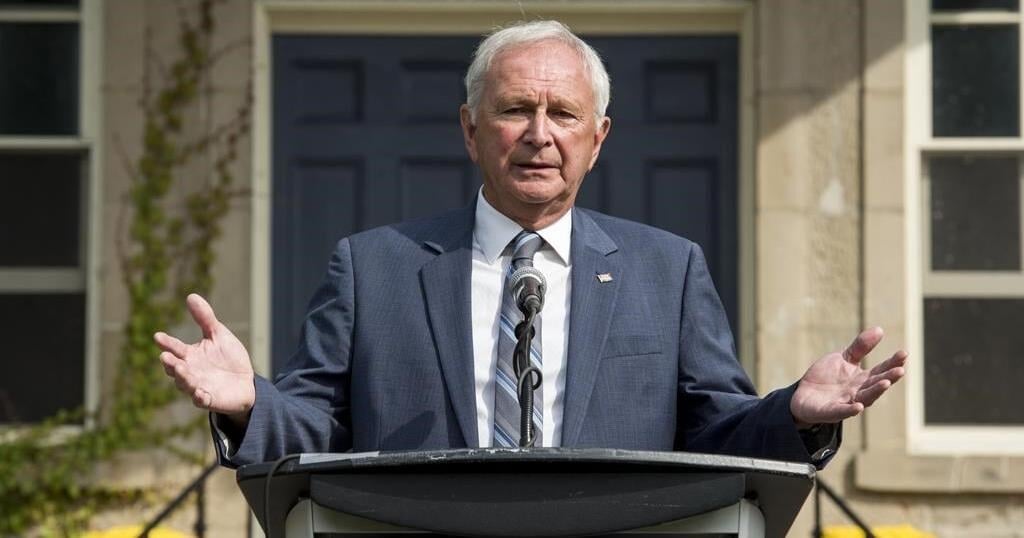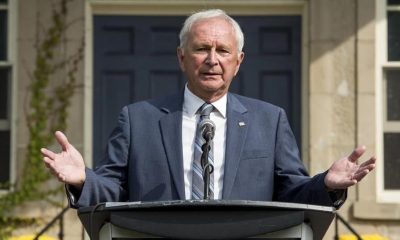In a few days, Americans will begin voting in the midterm elections. Control of the House and the Senate is up for grabs. Two years ago, Joe Biden and Donald Trump were locked in a similarly close battle for the White House. By that point, 2020 had already been extraordinarily eventful, even by the standards of presidential election years. The pandemic, the economic downturn, the protests following the murder of George Floyd — all appeared to herald political change. The moment seemed like a “plastic hour, ” a time that is ripe for national transformation because “an ossified social order suddenly turns pliable,” as George Packer wrote in the Atlantic then.
Politics
Perspective | A hard 2020 lesson for the midterms: Our politics are calcified – The Washington Post

Instead, Biden’s victory was narrow. The Democrats won slim majorities in the House and Senate. The Republican Party didn’t consider the election to be a repudiation and has yet to reject Trump as an election loser.
The plastic hour hasn’t come, and we seem no closer to political realignment today. American electoral politics doesn’t feel malleable. It seems set in stone.
Part of the reason is the well-known and long-standing trend in partisan polarization. Voters and leaders in the two major parties are not only more ideologically distant from each other but also more likely to describe each other in harsh terms. In the fall of 2020, 90 percent of Americans said there were important differences in what the parties stood for — the highest number recorded in almost 70 years of American National Election Study surveys.
But polarization is not the whole story. Something more is happening. Voters are increasingly tied to their political loyalties and values. They have become less likely to change their basic political evaluations or vote for the other party’s candidate. This is not just polarization but calcification. And just as it does in the body, calcification produces rigidity in our politics — even when dramatic events suggest the potential for big changes.
Calcification derives from more than long-term polarization. It is rooted in very recent divides between the parties on issues tied to racial, ethnic, national and religious identities. A key driver of these differences was Trump, whose hard-line positions on issues such as immigration led Democrats to shift to the left. For example, in the seven years since Trump’s presidential campaign began, there has been more partisan polarization on whether to increase immigration than there was in the prior two decades, according to Gallup polls.
Americans’ political priorities also feed calcification. The issues that Americans consider most important tend to exacerbate their differences, not mitigate them. During the 2020 campaign, the most salient issues to Republicans included opposing Trump’s impeachment, building a border wall and fighting reparations for slavery. Democrats’ priorities included impeaching Trump, opposing Trump’s restrictions on immigrants from Muslim-majority countries, and abortion rights.
By contrast, the issues on which there was more bipartisan consensus were less important to voters. For example, most Democrats and many Republicans are willing to raise taxes on the wealthy. In 2019 Nationscape surveys, 56 percent of Democrats and 33 percent of Republicans wanted to raise taxes on those making at least $250,000, with the rest opposed or unsure. But for both parties, tax policy was less important than abortion and immigration. This also helps explain why Trump could sign a tax bill that actually cut taxes on the wealthy without losing support from these Republicans. Within the GOP, identity politics appeared more important than economic populism.
Paradoxically, a calcified politics co-exists with frequent changes in who controls the government. This is because of the increasing parity in the two parties’ electoral strength. You can see partisan parity in the national electorate: By 2020, the Democratic advantage in party identification was the smallest in 70 years — just four percentage points. Partisan parity is visible in Congress as well, where the parties can expect to compete for control in most elections, producing what the political scientist Frances Lee has called “insecure majorities.” Right now, the Democratic majorities in the House and Senate certainly fit that description.
Calcified politics and partisan parity combine to produce a self-reinforcing cycle. When control of government is always within reach, there is less need for the losing party to adapt and recalibrate. And if it stays on the same path, voters have little reason to revise their political loyalties.
In our research on the 2020 election, we found evidence of calcified politics everywhere. Major events like the coronavirus pandemic and Floyd’s murder did not disrupt partisan alignments. Instead, those events were subsumed into the existing axis of partisan conflict. Trump’s push to reopen the country in April 2020 created partisan divisions on policies such as closing businesses and restricting travel. And after initially sympathetic comments about Floyd, Trump and other Republicans pivoted and attacked the racial-justice protests. Any “racial reckoning” that occurred was largely within the Democratic Party. When Floyd’s killer, Derek Chauvin, was convicted in April 2021, some conservative politicians and pundits attacked the trial, producing a historic gap between Republicans and Democrats in their views of the verdict.
Calcified politics was evident in the election’s outcome as well. To be sure, the changes between 2016 and 2020 were just enough to help Biden win. But those changes were small by historical standards. The average change in Democratic vote share in the states was just two points in absolute value, compared with 3.3 points between 2012 and 2016. At the county level, the average change between 2016 and 2020 was the smallest in consecutive presidential elections in at least 70 years, according to our analysis.
The same thing was true among individual voters. Drawing on surveys of the exact same voters in 2012, 2016 and 2020, we found more movement between 2012 and 2016 than between 2016 and 2020. For example, in 2016, 81 percent of those who voted for Barack Obama in 2012 reported voting for Hillary Clinton, 9 percent reported voting for Trump, and the rest reported not voting or voting for another candidate. Those 9 percent were the famous “Obama-Trump voters” who helped propel Trump to a slim electoral college victory. But in 2020, 95 percent of Clinton voters reported voting for Biden, and only 2 percent reported voting for Trump.
The greater stability between 2016 and 2020 flew in the face of speculation that Biden could somehow win back Obama-Trump voters. In fact, we found that 87 percent of Obama-Trump voters stuck with Trump. And most Romney-Clinton voters stuck with Biden. The swing voters of 2016 became loyal partisans in 2020.
Moreover, the election appeared to intensify the trends underlying calcification. There was continued partisan polarization: People saw Trump as more conservative than he was in 2016 and saw Biden as more liberal than Clinton. Democratic and Republican voters were further apart on a number of issues compared with 2016. And people’s views on key issues were more correlated with how they voted in 2020 than in 2016.
Polarization also helps explain a central puzzle of 2020 that remains relevant today: how Trump managed to increase his vote share among voters of color, especially Latino voters. After the election, there were various boutique explanations for specific groups: Biden was said to have lost votes among Cuban and Venezuelan Americans in Florida because they were concerned that the Democratic Party had become too “socialist”; for Mexican Americans in the Rio Grande Valley of Texas, it was because they feared losing oil-industry jobs under a Democratic president who wanted to wean the country from fossil fuels.
But Biden lost votes among many kinds of Latino voters in many parts of the country, as well as among other voters of color. Polarization helps to explain that. We found that, compared with 2016, Trump gained support among conservatives in every major racial group, including Black and Latino voters. For Latinos in particular, these gains exceeded his losses among more liberal voters, leading to a small net change in his favor.
Those changes among Latinos were not enough to reelect Trump. But a shift of even a few percentage points can matter. This is the irony of calcified politics and partisan parity: Big events may produce only small changes, but small changes can have big consequences. Small changes were the difference between a Democratic or Republican president in 2020 and could be the difference between a Democratic or Republican majority in Congress after 2022.
The prospect of quickly regaining congressional majorities meant the GOP did little soul-searching after its loss of the White House. It refused any autopsy of the defeat, unlike after the 2012 election. In states where the party retained power, GOP leaders have pushed an ambitious conservative agenda, especially after the Supreme Court struck down Roe v. Wade. Meanwhile, Trump has persisted as a force within the party, with candidates courting his endorsement and mimicking his beliefs and style. And thus the cycle of partisan parity and calcification has continued.
The aftermath of the 2020 election also revealed an especially pernicious consequence of this cycle: It increases the incentive for people to countenance their own party’s undemocratic behavior in order to win an election. After his loss, Trump and his allies endorsed baseless claims and even illegal means to overturn that election. If Republicans embrace or appease such measures in future elections, then a national transformation will really be upon us — and our democracy will hang in the balance.
Politics
New Brunswick Liberals ask Higgs to apologize for ‘joke’ about dead supporter

FREDERICTON – New Brunswick‘s Progressive Conservative leader disrespected the province’s residents by presenting the death of a Liberal supporter as funny, the party said as it called for Blaine Higgs to apologize.
Higgs drew the party’s ire during remarks made at his Thursday campaign kickoff event in Quispamsis, N.B., held hours after he dissolved the legislature and officially triggered the campaign leading up to the Oct. 21 provincial election.
His speech to party faithful included a second-hand anecdote of a conversation that purportedly took place in 2014 between a party volunteer canvassing for votes and a newly minted supporter. At the time, Higgs was seeking re-election as the legislature member for the Quispamsis riding, which he has represented since 2010.
The conversation, the story went, began when the canvasser was leaving the home of a woman who had just voiced her intention to vote for Higgs.
“(The volunteer) said: ‘Thank you very much. That’s great.’ Then she started walking next door, and the lady said: ‘Oh, you don’t need to go there. She passed away a few weeks ago,'” Higgs said in his retelling of the story. “This campaigner — you know, very passionate individual — said: ‘I’m so sorry. Was she sick long? Or what happened? And the lady just said, ‘Oh, don’t feel too bad. She was a Liberal.'”
“I know that’s not an appropriate joke, but it was funny and it is true,” Higgs concluded.
Hannah Fulton Johnston, executive director of the New Brunswick Liberal Association, condemned Higgs’s anecdote in a statement issued on Friday in which she called the joke distasteful.
“The New Brunswick Liberal Association is calling on Blaine Higgs to apologize for this comment,” it reads.
“Making light of the death of any New Brunswicker is highly inappropriate for anyone and completely unacceptable for the premier of the province.”
Green Party Leader David Coon described the anecdote as disgusting and questioned whether the comment could be passed off as a joke.
“It’s a very dark comment,” he said on Friday.
Higgs, 70, has so far stuck to broadly populist messages as he seeks a third term as New Brunswick’s premier. His key issues so far have included bringing down the harmonized sales tax from 15 to 13 per cent and requiring teachers to get parental consent before they can use the preferred names and pronouns of young students in class.
When asked about the Liberals’ request for an apology, Progressive Conservative Party Executive Director Doug Williams shifted the focus back to past remarks from Liberal Leader Susan Holt and tried to draw a parallel between her and her unpopular federal counterpart.
“If Susan Holt is truly concerned about offensive comments, will she apologize for saying that concerns of parents about their children are ‘BS’? … Will she apologize for saying the Premier acts like a fascist?” the statement reads.
“The media have not paid any attention to these remarks, despite Progressive Conservatives raising them publicly. Just like Justin Trudeau, Susan Holt wants apologies for things that other people have done, and never wants to apologize for her own actions.”
This report by The Canadian Press was first published Sept. 21, 2024.
The Canadian Press. All rights reserved.
Politics
A look at British Columbia New Democratic Party Leader David Eby

VANCOUVER – A look at British Columbia NDP Leader David Eby.
British Columbia NDP Leader David Eby is in his first election campaign as party leader and is looking to capture the NDP’s second consecutive majority victory on Oct. 19. Here are some highlights from his life and career.
Age: 48. Born July 21, 1976, in Kitchener, Ont.
Pre-politics: An award-winning human rights lawyer, who was the B.C. Civil Liberties Association executive director, an adjunct professor of law at the University of British Columbia, president of the HIV/AIDS Legal Network and served on the Vancouver Foundation’s Health and Social Development Committee.
Politics: Eby, the MLA for Vancouver-Point Grey, was first elected in 2013, defeating then-premier Christy Clark in the riding, forcing her to run in a byelection in Kelowna. He became leader of the party and premier in 2022, replacing former premier John Horgan who left office due to health issues.
Personal: Married to family physician Dr. Cailey Lynch. The family recently welcomed a third child, daughter Gwen.
Quote: “For me, I feel the extra weight of the significance of the election in terms of can we preserve what’s made us successful over the years of working together as a province.”
This report by The Canadian Press was first published Sept. 21, 2024.
The Canadian Press. All rights reserved.
Politics
A look at Sonia Furstenau, leader of the Green Party of British Columbia

VICTORIA – British Columbia Green Leader Sonia Furstenau is running in the Victoria-Beacon Hill riding in the Oct. 19 election, returning to the capital after representing the Cowichan Valley riding since 2017.
Age: 54. Born June 8, 1970.
Pre-Politics: Bachelor’s and master’s degrees in history as well as abachelor’s degree in education from the University of Victoria. Furstenau has worked as a high school teacher in Victoria and Shawnigan Lake and served as a director with the Cowichan Valley Regional District for three years prior to entering provincial politics.
Politics: Elected to the B.C. legislature in 2017 for the Cowichan Valley riding and re-elected in 2020, shortly after winning the BC Greens leadership contest that year.
Personal: Furstenau recently moved back to Victoria, where she lives with her husband. The couple shares two sons, and Furstenau told The Canadian Press she is looking forward to becoming a grandmother for the first time in November.
Quote: “When we have a right-wing party pandering to these kind of culture war issues, and then we have the NDP that has abandoned so many of (its) progressive values … more than ever, we need BC Greens in the legislature to keep the focus on the health and well-being of people, communities, the environment and our economy.”
This report by The Canadian Press was first published Sept. 21, 2024.
The Canadian Press. All rights reserved.
-

 Politics23 hours ago
Politics23 hours agoGreens reject acrimony, setting them apart from other B.C. parties: Furstenau
-

 Politics22 hours ago
Politics22 hours agoA look at British Columbia New Democratic Party Leader David Eby
-

 Politics22 hours ago
Politics22 hours agoA look at Sonia Furstenau, leader of the Green Party of British Columbia
-

 News20 hours ago
News20 hours agoB.C. election campaign officially starts; Eby campaign bus on road
-

 Politics20 hours ago
Politics20 hours agoNew Brunswick Liberals ask Higgs to apologize for ‘joke’ about dead supporter
-

 News23 hours ago
News23 hours agoThree injured at Quebec mosque while trying to disarm man carrying knife: official
-

 News22 hours ago
News22 hours agoA look at John Rustad, leader of the Conservative Party of British Columbia
-

 News22 hours ago
News22 hours agoOttawa’s $2B loan for satellites has Tories calling for Elon Musk to step in































